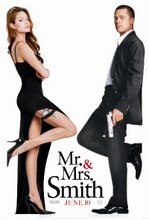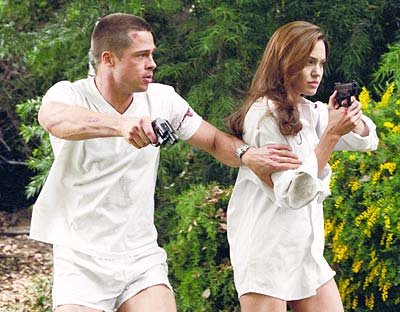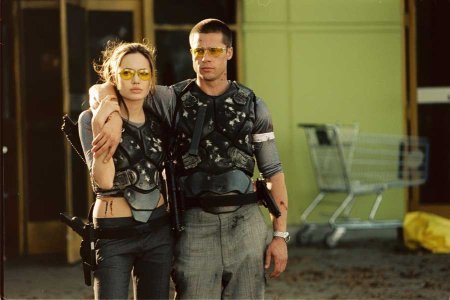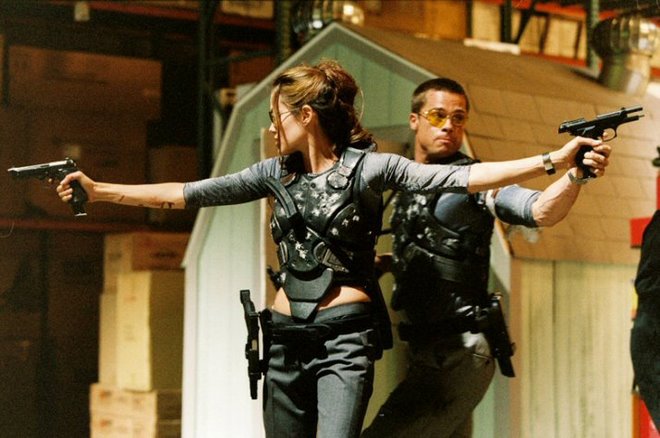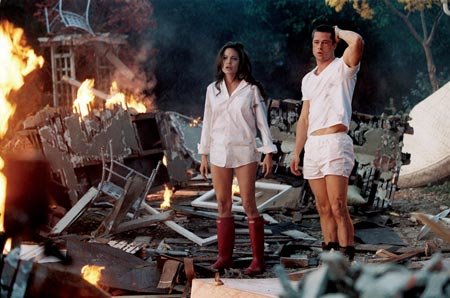“That’s the second time you’ve tried to kill me today…oh come on it was jus a little bomb”
How are women represented differently now compared with the past and negative stereotypes, paying particular attention to ‘Mr and Mrs Smith’?
When considering the ‘representation’, words such as ‘label’, ‘portrayed’, ‘image’, and ‘constructed’ are a few that come to mind. Representation as a concept is often concerned with stereotypes, which categorize a group of people or a place by only a few characteristics. Stereotypes of gender roles have dramatically changed within today’s society, as women today challenge themselves in taking up a range of opportunities which allows them to express themselves more fully. The action film genre is typically male dominated, where men take upon leading masculine roles, which entail playing the active part, while women take on a more passive role and are often only there were to be looked upon as ‘sex objects’, as Mulvey states: “why are so many women in films showgirls, strippers etc” However, award winning, action comedy film ‘Mr and Mrs Smith’ (2005, Doug Liman, USA) seems to play around with the traditional roles. Both Angelina Jolie and Brad Pitt undertake challenging roles where Jolie plays the part of a ‘dominant powerful woman’, Brad Pitt still plays the part of an active character although seems often to be passive and subordinate towards Jolie. ‘Mr and Mrs Smith’ significantly portrays women in a more positive way where they are seen to be taking on the active role in being dominant and are not being ‘labeled’ according to the fixed stereotype of a woman. This suggests that we could finally be in a post-feminist era.
By tradition, ‘Women are constantly portrayed in the media as sex objects of the male gaze’ Women have had no free control of their own actions and this would include them having control of the way they present themselves, the way they lead their lives and also even having control over their own bodies. Their restriction in society was based on and refined by the generalised ‘stereotyping’ of women, so this did not allow them to break free from the patriarchal and misogynistic view of women. They were generalised and discriminated against: an inferior social group who could not be left on there own to make there own decisions in society. Women have consequently been under-represented in films as it was only acceptable for a woman to be in a film. If she was being objectified ’20 to 35 per cent of characters were female in the 1950’s to 70’s ’. but a study showed by Cumberbatch showed how ‘the advertisers had seemingly become wary of showing women doing housework for example’ .The, with feminism, the number of women on screen increased by double by the 1980’s although women were still restricted by the ‘glass ceiling’ and there were still more men than women on screen according to David Gauntlett. But it also can be argued that the representation of women was increasing in the other film genres including the slasher genre. Carol. J. Clover introduced her work of ‘Men, Women, and Chainsaws’ this powerful book consisted of how women are becoming a character who plays an active part throughout a whole film.
Simply, the argument is that the audience is often stereotyped as a teenage boy who is placed to identify with the killer and the subjective camerawork especially in Halloween, (1978, Carpenter John) and Friday The 13th, (1980, Cunningham.S.Sean). However, Clover proposes that ‘this is the only case up to a point and that point is the Final girl’ .Characters such as Sally Hardesty and Laurie Strode is in the first Friday The 13th movie, there characters seemed to play a resourceful, unswayed by lustful pleasures and, rather than just females who are waiting to be saved by men, the ‘Damsel and Distress, conforming to there typical ‘stereotype. But these female charters confront the monster for the audience and have the courage and common sense to destroy, Carol states:’ It may be Donald Pleasence who fires the final shot, but it’s Jamie Lee Curtis who struggles with, stabs and unmasks Michael Myers in the last twenty minutes of Halloween’. At this instant, it Is recognisable the impact on female roles in film was increasing by the 1970s and the active part she played drew her away from Laura Mulvey and her theory slowly becoming invalid
However, women were still consistent as the society was changing due to the Second World War, which then entailed there being a need for women more as the men were fighting in the war. Women were encouraged to take on jobs at the factory to take their place working in factories. Women at this point found that they could break free from the norm and finally felt that they could be independent for once, this then continued when their husbands retuned back from the war. Nowadays, women are in control of how they perform and present themselves in society, from successful business women, lawyers and sportswomen to modeling for vogue magazine, and even in ‘Lads mags’ Nuts and Loaded. ‘Sleeping with a supermodel would be about as pleasurable as shagging a bicycle’ .Presenting women like this shows that they are in complete control of how they are presented in the society as it reflects their opinion on how they represent themselves. As women are aware that ‘sex sells’ But they like to see themselves in a complete different light to that, as prime example, Cate Blanchette ,current movie star, was presented in ‘Esquire’ magazine which images of her but not the stereotypical half nude images but presenting her with more character and not just a 2D label. An Article headlined ‘feminism’ had never been published although Natasha Walter’s – on the move quotes a section from this un printed article, talking how feminism turns the language of women’s liberation and present us with ‘I want to be judged on my achievements as an individual, not as a woman,’ she says. ‘We should not be categorized by our sex.’
As women talk about how they shouldn’t be categorized there has been a generalised representation on women as they either have been classified as ‘the whore’ which is the passive, inferior character and allows society to sexually objectify them and that makes hem victims of the ‘male gaze’. The ‘whore’ can be seen in ‘The girl next door, Greenfield Luke (2004) Elisha Cuthbert who plays Danielle conforms to a passive character who believes she cannot break free from the porno industry.’ the Madonna’ is the second group which shows women to be conducting domestic tasks which include cooking cleaning and being portrayed as a good ‘housewife‘. Women have often been stereotyped as a ‘dumb bimbo’ or the ‘housewife’ which then links back to the patriarchal society and how they categorised women, this then re impose the humiliating views upon their position in society.
‘Pretty woman, 1990, Marshall Gary’ is a major example of this as it was an introduction to try to represent women in roles typically given to men. As Vivian Ward (Julia Roberts) has been represented as ‘the whore’ who reinforces the idealistic views of being controlled by the dominated male. Vivian represents the typical stereotype of a woman, degraded and being exploited as she plays the role of a prostitute in the film, which is, typical male preference, as it encourages the ‘male gaze’ as the woman has no control of her own body and actions’. Simply, ‘eye candy to appease the male gaze’ The male Edward Lewis (Richard Gere) in the film typically plays the rich, middle class white male, associating with the stereotyped male that would approach a ‘prostitute’ but in this case he approaches her in order to save her as he is only a man in a legal but hurtful business and needs an escort for some social events, and hires a beautiful prostitute he meets. Arguably, his character is making the decisions which reflect the society. Julia plays a woman that finds herself selling her body as she believes that that is the only way out, she is typically ‘promiscuous, stupid, uneducated and helpless’. Throughout the film she has been represented to be the woman that is living in a dangerous lifestyle, which is what men want theoretically, but then it can be argued that she has adopted a male tradition, as you would see the male within the similar position but it would be ‘pimping’ his women.
Women’s roles have changed dramatically since the early 1970’s when the activists were battling for women’s liberation and equal opportunities at a time of great unrest and social upheaval for many social groups. A lot of the modern film represents this especially as the 21st century celebrates female sovereignty and their position in being the same towards men in society. The society norms and values have been broken as films such ‘Mr and Mrs Smith’ promotes the rising and change in the female character, as it highlights the female dominance and also challenges the patriarchy society. An example of this change would be careers that have women have adapted to, taking up jobs that fill up their whole lifestyle, where there is no room for a male figure.
‘Don't flatter yourself. What I did this evening was for Queen and country’ Thunderball, 1965, Young Terence. The James Bond collection has distinctive but then a very typical style, also representing the women in their films. Throughout the series of films, women were objectified as ‘sex objects’ for the males viewing pleasure. In the films, women would walk around in ‘revealing’ clothing which is used to seduce the men around them but in particular, Bond. The stereotype that follows up would be the stereotype of portraying an unmarried female who needs to be saved. This is similarly Snow White (Show White and the seven Dwarfs), Sleeping Beauty (Sleeping Beauty), Princess Zelda (The Legend of Zelda as they are fantasy Disney stories but they are in need of a male to save them as they are at their weakest, this then emphasises the traditional narrative where women conform to the ‘damsel and distress’ stereotype. Which then links Propp’s theory about how there is a male who consistently is the hero and the female who seeks the man who will save her and live happily ever after.
Angelina Jolie takes the challenge to take on a role in which consists of breaking the traditional qualities of an action film, she plays the woman that seems to be lonesome on a holiday, the police are looking for her, this indicates the that women are living dangerous lives and clearly, ‘unattached’. We could argue whether she is independent as when the police are looking her Brad Pitt is waiting at the bar, stealing away the typical position of a woman, she then approaches him typical position of the male which indicates the use of role reversal in film. Represents Jolie as the damsel is distress as she walks up to Brad Pitt in order to get saved by the police he replies ‘she’s with me’ Brad Pitt seems to have taken the role of the male that saves the ‘damsel in distress’, which portrays Jolie to be dependent on Brad.
Historical text ‘Bonnie and Clyde, 1967, use the same conventions, as Bonnie seems to be an independent she seems to be in the driver’s seat, this could be portrayed as a way of taking control in the relationship and by her controlling the gear stick it shows that she’s in control of the ‘phallic symbol’ which is big, long and hard which could be the substitute for the penis. At this point we know that Bonnie has ownership over Clyde, but then during the car journey they have an argument, Clyde decides to walk out of the car, at this point we identify with Bonnie as she feeling vulnerable and afraid of losing Clyde she then comes to her senses and explains to him that he is ‘the only one’ for her. Therefore, the ideology would be that in order for a woman to succeed, she needs the opposite sex by her side.
Angelina Jolie represents two kinds of women in the film, she firstly plays the ‘domestic’ woman, whose interests are family unity and duty, and she plays a woman that is secretive and commits activities that you would not associate with a woman. Jolie has her hair clipped back in curls; she is preparing food in the kitchen for husband Brad for when her returns home. Similarly done in adverts of the 1960’s where woman were all make up perfect, but in the kitchen ‘now if you can’t get to his heart, there’s no going wrong with a home baked pie’ and ‘‘Using women in the kitchen and Bathroom adverts Clearly we see an emphasis on that how women are only good for one thing and that’s performing domestic activities in the kitchen. Jolie conforms to these ideologies as she is performing these acts but the difference is that she represents a very strong minded person and seems to be almost equal towards her husband. Remarks such as ‘ Brad- would you pass the salt honey’ and her replying ‘it’s in the middle of the table’11 shows that she does not worship her husband at all, Jolie takes the role of being the one in control and speaking her mind.
At one point Jolie is dressed in a black coat with her hair tied back, Brad then asks ‘you going out’ she replies ‘only for a quick one’ usually the woman would be asking the question to the male but in the case they have switched the roles showing the women are dominant and independent. The connotations of the ‘quick one’ are sexual as it could represent that she may well be going out for a bit of fun. She approaches a club, where she is approached by a male, who then opens the doors for her, shows that she has authority. He leads her into a room and leaves her waiting, the camerawork shows Jolie has a low angle shot to emphasise her dominance. A male then enters and smiles she drops her bags, fast, she then undoes her buttons and rips of her jacket revealing a ‘strippers outfit’, she has conformed to the’ male gaze’ as the clothing is tight and revealing. Jolie is also wearing red lipstick, red connoting danger, and a woman living a dangerous lifestyle. Laura Mulvey states, ‘in film women is seen as other, as an object not a subject. In a way she represents the unconscious of the male because she is always the object he is looking at and never is able to speak for herself’ , Jolie signifies a woman that knows her positions in society, as even though she is seen as a ‘stripper’ she is also the one holding the ‘whip’ representing, ‘phallic symbol’, by Jolie whipping the male shows she’s got ownership of it. In ‘Bonnie and Clyde’ Bonnie clearly shows a role reversal ,where she is in the possession of money, and is distributed between four people, when she receives the less amount she now conforms to an dominant role towards Clyde as she speaks up to let him no that she received less amount of money, ‘I did as much work as she did, I should get more’ Bonnie now has shown her ‘girl power’, which highlights that she is not ready to settle for second best any longer.
‘Mr and Mrs Smith’ obviously challenges Laura Mulvey’s theory ‘Men as the dominant group have been the looker (the subjects; women the objects)’ her theory to be out dated as women are more the dominant and controlling one. Angelina Jolie has the characteristics of a male in the film.
Another fairly recent film, although not an action film is ‘Erin Brokovich (2000), Steve Soderbergh, (2000)’, starring Julia Roberts. She adopts the characteristics of a male, as she seems to be women with empowerment being herself and not taking orders from anyone, as well as being attractive. However, she portrays a strong, feminist character’ as she gains an interview at a law firms where she gets interviewed by a male interviewee she manipulates him by talking about his office ‘I like what you’ve done with you’re office’ .Clearly showing that she needs to use her looks and charm to gain the position. We are almost made to believe that society is changing especially for the role of women.
Even though ‘Mr and Mrs Smith’ portrays the woman in a changed light, we could say that the film was more to do with the success of ‘detective and assassin’ fans and not to do with the movement of women in society. Jolie plays a more ‘cross gender appeal’ Where the female audience are attracted to her for being a confident, intelligent women allowing her to be their role model but t the same time the male audience can be seen to be taking up on the idea of women actually being accepted to perform the same roles as they do and they then are forced to undergo ‘cross gender identification’
Furthermore, even though women are seen to be breaking free from the stereotype they will still overcome the fact the glass ceiling is still at present, as the more leading sex will always remain with the power, showing the patriarchal society. The women are seen either to be the main or supporting role as the first thing that we recognize is the presence and sexual charm ‘She is a failure if she is not beautiful’ Such examples include ’Kill Bill, Quentin, Tarantino (2003) with Uma Thurman, ‘Tomb Raider, Simon West, 2001) with Angelina Jolie and further. The sexual attracted gaze is available for the male audience, but then argue that the female also are ‘forced to objectify’ as they are placed as the one that is in the trap of ‘the gaze’.
Women may need to revert to the masculine beliefs in order to succeed in society. As women cannot succeed without having masculine qualities, this may lead to the respect as characters from the male audience and accepting the woman as an actress.
Concluding, it obviously has had an impact on today’s society and that there has been a turnaround in especially through Angelina Jolie’s representation in ‘Mr and Mrs Smith and also along with the other. As she is characteristically pinched away from the typical female role ‘damsel in distress’ and she challenges the typical stereotypes of a woman. The film indicates that the woman was known to be playing the one ‘inferior and passive’ but know has taken up the centre role and made the traditional values extinct.
Mulvey’s theory of active/male and passive/female is less applicable as mainstream Hollywood films are moving away from the predictable narrative structure, allowing women to gain acceptance in society. However, women still need to be wary as the glass ceiling still stands present in society and they are firmly attached in our allegedly post- feminist society.
Inderdeep Flora
3,193
Wednesday 30 April 2008
Subscribe to:
Posts (Atom)
